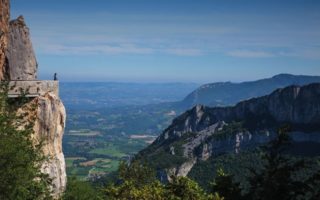The Dordogne and Its Caves
The famous Dordogne caves (grottes) are situated at various sites throughout the region. Created originally by glaciation and water erosion, they take many forms and are fascinating for all ages.
Not all are the classic cliché with stalactites dripping down or stalagmites rising from the ground, there are multi-level, dry caves with far reaching galleries like at Rouffignac. The complex extends for a considerable way underground, others have interesting entrances with a number of methods for gaining access. Aside from stairs and slopes which you might expect, you can also experience being lowered inside in a horse-powered basket!
The original inhabitants were animals, including bears, who hibernated inside. You can still see traces of the ‘basins’ they made in the ground for their ‘beds’. When they awoke in the spring, they sharpened their claws on the cave walls and these marks can also still be seen.
The next occupants were prehistoric man, who built shelters near the entrance of the caves and benefited from the protection of the rockface. Eventually he ventured deep inside and truly left his mark, which has fortunately been preserved for our benefit. Dates for his occupation vary, but a good guide is 15,000 – 35,000 years ago, certainly for a long time, the Dordogne has always been popular!
One site, La roque St Christophe is the oldest and largest site in Western Europe. It has over 100 caves covering 900m of the valley and was home to over 1,000 people.
Now you and your children can see many examples of these early inhabitants and the legacy of the most exquisite paintings of a variety of animals that existed at the same time, like woolly rhinoceros, ibex, ancient horses and mammoths. Some of the images are abstract designs and there are hand prints, plus some images of large groups of animals drawn in virtual darkness that would indicate the artist was very sophisticated to be able to create this without being able to see the total picture at any one time.
In the Caves at Rouffignac some 17,000 years ago, an artist lay on his back and in a space one metre high from floor to ceiling and one km from the entrance, drew many kinds of animals in all shapes and sizes. Only now, in modern times are they fully appreciated.
It is thought that these images were not intended to be seen by large numbers and with the absence of human depictions, probably had symbolic or sacred significance – a meaning beyond their visual appearance, so that it was necessary for the artist to separate their portrayal from human shapes. But the truth will never be known.
Just some of the sites:
Gouffre de Proumeyssac
Le Bugue
The famous Cristal Cathedral, an immense underground vault with walls decorated with a multitude of crystallisations, light plays off the walls to modern musical accompaniment
Open: Feb, Nov, Dec 2pm – 5pm; Mar, Apr, Sept, Oct 9.30am – 12pm & 2pm – 5.30pm; May, June 9.30am – 6.30pm; July, Aug 9am – 7pm
Grotte de Bara-Bahau
This cave was discovered in 1951, it has pre-history art and evidence of the bears that lived there 35,000 years ago
open: Feb to June 10.00 to 12.00 &nd 2.00 to5.30; july and Aug 9.30 to 7.00; Sept to Dec 10.00 to 12.00 and 2.00 to 5.00
Les Eyzies
Combaralles has more than 600 wall decorations; Font-de-Gaume has 200 images and Le Poisson is the earliest depiction of a fish in the World
Cap Blanc, Les Eyzies en Périgord
More prehistoric art
Open: May – October
Grottes du Roc de Cazelle
Les Eyzies
Caves and underground passages, cliff paths and prehistoric dwellings.
Open: Dec, Jan 11am – 5pm; Feb to April, Oct, Nov 10am – 6pm; May, June, Sept 10am – 7pm; Jul, Aug 10am – 8pm
Grand Roc & Les Abris de Laugerie Basse
Guided tours for the cave in English lasting about 30 minutes. The cliff face has been inhabited for over 15,000 years
Open: 10am – 6pm & 9.30am – 7pm in high season
Le Roque St. Christophe
Peyzac-le-Moustier
The oldest and largest prehistoric cave site in Western Europe that housed over 1,000 people.
Open: Nov, Dec, Jan, Feb 11am – 5pm; Mar,Oct 10am – 6pm; Apr, May, Jun, Sept 10am – 6.30pm; Jul, Aug 10am – 7pm
Grottes de Villars
Villers
So far, some 13 kilometres of caves have been mapped, prehistoric paintings from the Magdalenian period and an above-ground café
Open: Oct 2pm – 6.30pm; Apr, May, Jun, Sept; 10am – midday and 2pm – 7pm; Jul, Aug 10am – 7.30
Lascaux II
Montignac
The most famous cave? The cave was discovered by 2 small boys out exploring but, unfortunately it became so famous and popular that this is a perfect replica because the original was being damaged by the presence of so many visitors.
Open: Nov, Dec, Jan, Feb, Mar 10am to 12.30 & 2pm – 5.30pm; Apr, May, Jun, Sept, 9.30am – 6.30pm Jul, Aug, 9.30am – 8pm
Share to: Facebook Twitter LinkedIn Email
More in beach, children, dordogne, fishing, guides, history, people
Leave a reply
Your email address will not be published. Required fields are marked *



